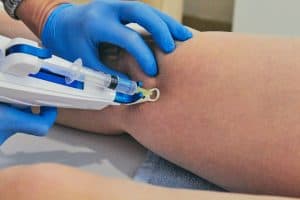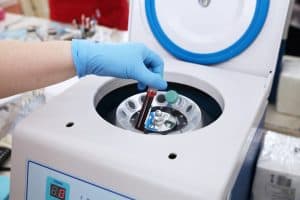PRP Knee Injections
Non-invasive knee and ankle pain solutions that work:
Regenerative Medicine and Interventional Orthopedics: explore all of your options before saying “yes” to surgery.
The doctors at Advanced Vein Center , our Surgeons focus on Regenerative Medicine and other related, minimally-invasive techniques. We know Interventional Therapy. It’s a blending of time-honored mainstream medicine and newer, cutting edge techniques which stimulate the body’s innate healing response.

Are you sick and tired of simply putting up with chronic knee pain? Thankfully, you may no longer have to. The rapidly expanding field of Regenerative Medicine now offers several innovative, minimally invasive, injection based therapies. These have the potential to aid the body in doing one of its most important jobs—healing chronically damaged tissue. This can often prevent or take the place of traditional invasive surgery.
Knee pain is nothing if not extremely common. It is estimated that about 33% of American adults over 65 currently have a chronic knee complaint. The presence of osteoarthritis or “wear and tear” arthritis, usually complicates the matter. This can be seen, in its most severe form, as a “bone on bone” knee joint.
Other advanced cases feature a torn meniscus. This is the large cartilage pad located directly behind the kneecap which is essential for normal function. Short of surgery, and now Regenerative Treatments, this type of gross physical damage is unlikely to mend. Today treatments such as Platelet Rich Plasma (PRP) Therapy, AMPP® and nSTRIDE® Injections offer hope for both stubborn conditions. Read on for more details.
PRP Injections

Tube of blood is placed in a medical centrifuge for plasma lifting
Platelet Rich Plasma (PRP) injections are derived from a patient’s own blood. They are prepared immediately prior to treatment using a small sample, usually only one or two vials. These are collected by standard vena-puncture, the same method used to draw blood for medical testing.
A laboratory centrifuge is then used to separate the whole blood out into its components. These include red cells, various white cells, and platelets. Platelets are extremely small, cell-like particles which are responsible for your blood’s ability to clot. The (literally) platelet-rich layer is then harvested from the vial, purified, and is ready for injection into damaged tissue.
Once injected, PRP triggers a healing and remodeling phase that will continue for several months. It is the ultimate goal of a Regenerative Medicine treatment like PRP to force the body to heal itself. PRP and related techniques must be used on the correct candidates. When used appropriately, however, they can deliver serious improvement even in treatment-resistant conditions such as arthritis of the knees.
From start to finish the prep time for a PRP treatment is about 20 minutes. The delivery of the injections themselves takes only minutes, even if many are required. Medical ultrasound may be used if your doctor feels that visual guidance is necessary. This is the same ultra-safe technology used to visualize babies in utero, and involves no harmful ionizing radiation.
Why Not Steriods?
Powerful steroid injections, usually Cortisone, are also problematic. These miracle drugs reduce inflammation within minutes and can greatly reduce symptoms and improve function. Doctors know that they often deliver fantastic short-term results, yet they’re not suitable for mid to long-term use. Repeated injections inhibit healing on the cellular level, and that’s just one of Cortisone’s well-documented, serious side effects. They’re incredibly useful, yet can ultimately make a foot or ankle condition worse.
Many doctors also use steroid injections or prescribe oral steroids to their patients too frequently. This practice is slowly changing, however, as the medical community becomes more aware of their potentially detrimental effects.
Both steroid medications and surgery will always have their place. They should never be first-line options, however, especially when effective non-invasive, non-pharmaceutical options exist. It is this type of treatment that doctors and researchers in the field of Regenerative Medicine develop and deliver.
Can PRP Injections For Knees Prevent The Need of Surgeries?
PRP injections for knees excel at reducing pain, improving function and even promoting healing, which can help delay and even completely prevent the need of surgery in the future. PRP is most useful for those individuals who are suffering from conditions like osteoarthritis, tendon injuries, and mild or moderate cartilage damage. This treatment promotes the regeneration of tissues, reduces inflammation, and even allow people to manage systems non-surgically. So in conclusion, yes, it may have a chance to prevent the need of surgeries, but it depends on the severity of condition too.
Lastly, for advanced conditions, PRP can provide temporary relief, but it will not eliminate the problem fully, so you may need the surgery later.
How Many PRP Sessions Are Usually Needed For Knee Treatment?
Usually, only 1 to 3 PRP are enough for knee treatments, but depending on the severity of the condition and individual’s response to therapy, they may change. Most of the time, patients will start with a single session, after noticing the changes, your doctor will decide whether you need more sessions or not. Lastly, for more chronic issues like osteoarthritis or tendon injuries, you might need 2-3 sessions that are spaced several weeks apart for the best results.
How Soon Am I Allowed To Return To Exercise Or Sports After PRP Knee Injection?
After the treatment, your doctor will recommend you to not involve in any physical activities for at least 48 to 72 hours to allow the injected area to start healing, which means you aren’t allowed to return to any intense activities right after the treatment. Therefore, consider light activities, like gentle walking which can be continue within few days after the treatment. But high impact ones should be prevent for at least 1 to 2 weeks depending on the severity of your injury or your doctor’s guidelines.
What takes place while recovering?
Following the operation, your doctor might suggest that you:
- For the first three days, ice your knee for 20 minutes every two to three hours, and during that time, take Tylenol to ease pain.
- Avoid NSAIDs like ibuprofen since they may interfere with PRP’s effects.
- Rest well, and stay away from activities that cause pressure on your knee.
- To keep the weight off of your knee for a few days, you might need to use crutches or a walking frame.
Follow your doctor’s recommendations for follow-up appointments.
How long does a typical PRP knee injection procedure take, from start to finish?
The duration of a PRP (Platelet-Rich Plasma) knee injection procedure can vary, but it generally takes about one to two hours from start to finish. Here’s a breakdown of the typical timeline:
1. Preparation: The initial steps involve preparing the patient and the PRP. This includes drawing a small amount of the patient’s blood, usually from the arm, to collect the platelets for PRP.
2. Blood Processing: The drawn blood is then processed to separate the platelets and other components. This step may take approximately 15 to 20 minutes, depending on the specific processing method used.
3. Injection: Once the PRP is prepared, the orthopedic specialist or healthcare provider will then inject the concentrated platelets into the targeted area of the knee. The injection itself typically takes only a few minutes.
How does the cost of PRP knee injections compare to other knee treatment options?
The cost of PRP (Platelet-Rich Plasma) knee injections can vary widely based on factors such as geographical location, the healthcare provider’s fees, the specific PRP preparation method used, and any associated medical facilities or services. Generally, the cost of PRP knee injections may be comparable to or slightly higher than some other knee treatment options. Here are considerations for cost comparisons:
1. PRP vs. Corticosteroid Injections: PRP injections may be more expensive than corticosteroid injections, a common non-surgical treatment for knee pain. While corticosteroid injections can provide temporary relief, PRP injections are often considered for their potential to stimulate healing and tissue repair.
2. PRP vs. Physical Therapy: Physical therapy is another non-invasive approach to managing knee issues. The cost of physical therapy sessions may accumulate over time, but it is generally lower than some invasive procedures.
3. PRP vs. Surgical Interventions: Compared to surgical options like arthroscopic surgery or knee replacement, PRP injections are often more cost-effective.
